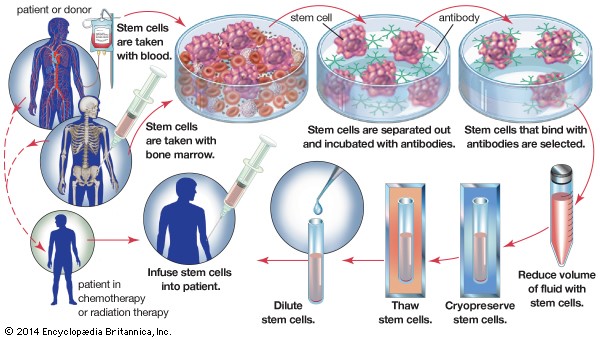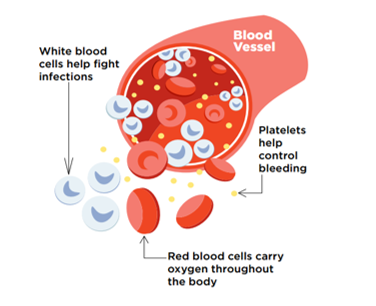Bone Marrow Transplant
Bone Marrow Transplant

About
Before the transplant, Chemotherapy, Radiation, or both may be given. This may be done in 2 ways:
- Ablative (myeloablative) treatment: High-dose chemotherapy, radiation, or both are given to kill any cancer cells. This also kills all healthy bone marrow that remains, and allows new stem cells to grow in the bone marrow.
- Reduced intensity treatment, also called a mini transplant: People receive lower doses of chemotherapy and radiation before a transplant. This allows older people, and those with other health problems to have a transplant.

There are 3 kinds of bone marrow transplants:
- Autologous bone marrow transplant: The term auto means self. Stem cells are removed from you before you receive high-dose chemotherapy or radiation treatment. The stem cells are stored in a freezer. After high-dose chemotherapy or radiation treatments, your stems cells are put back in your body to make normal blood cells. This is called a rescue transplant.
- Allogeneic bone marrow transplant: The term allo means other. Stem cells are removed from another person, called a donor. Most times, the donor’s genes must at least partly match your genes. Special tests are done to see if a donor is a good match for you. A brother or sister is most likely to be a good match. Sometimes parents, children, and other relatives are good matches. Donors who are not related to you, yet still match, may be found through national bone marrow registries.
- Umbilical cord blood transplant: This is a type of allogeneic transplant. Stem cells are removed from a newborn baby’s umbilical cord right after birth. The stem cells are frozen and stored until they are needed for a transplant. Umbilical cord blood cells are very immature so there is less of a need for perfect matching. Due to the smaller number of stem cells, blood counts take much longer to recover.
A stem cell transplant is usually done after chemotherapy and radiation is complete. The stem cells are delivered into your bloodstream usually through a tube called a central venous catheter. The process is similar to getting a blood transfusion. The stem cells travel through the blood into the bone marrow. Most times, no surgery is needed.
Donor stem cells can be collected in 2 ways:
- Bone marrow harvest: This minor surgery is done under general anesthesia. This means the donor will be asleep and pain-free during the procedure. The bone marrow is removed from the back of both hip bones. The amount of marrow removed depends on the weight of the person who is receiving it.
- Leukapheresis: First, the donor is given several days of shots to help stem cells move from the bone marrow into the blood. During leukapheresis, blood is removed from the donor through an IV line. The part of white blood cells that contains stem cells is then separated in a machine and removed to be later given to the recipient. The red blood cells are returned to the donor.
Why the procedure id performed?
A bone marrow transplant replaces bone marrow that is either not working properly or has been destroyed (ablated) by chemotherapy or radiation. Doctors believe that for many cancers, the donor’s white blood cells may attack any remaining cancer cells, similar to when white cells attack bacteria or viruses when fighting an infection. Your doctor may recommend a bone marrow transplant if you have:
- Certain cancers, such as leukemia, lymphoma, myelodysplasia, and multiple myeloma
- A disease that affects the production of bone marrow cells, such as aplastic anemia, congenital neutropenia, severe immune system illnesses, sickle cell anemia, and thalassemia
- Had chemotherapy that destroyed your bone marrow
Risks
- A bone marrow transplant may cause the following symptoms:
- Chest Pain
- Drop in blood pressure
- Fever, Chills, Flushing
- Funny taste in the mouth
- Headache
- Hives
- Nausea
- Pain
- Shortness in breathing
Possible complications of a bone marrow transplant depend on many things, including:
- Whether you had chemotherapy or radiation before the bone marrow transplant and the dosages of such treatments
- Your age
- Your Overall Health
- How good of a match your donor was
- The type of bone marrow transplant you received (autologous, allogeneic, or umbilical cord blood)
Complications may include:
- Anaemia
- Bleeding in the lungs, intestines, brain, and other areas of the body
- Cataracts
- Clotting in the small veins of the liver
- Damage to the kidneys, liver, lungs, and heart
- Delayed growth in children who receive a bone marrow transplant
- Early menopause
- Graft failure, which means that the new cells do not settle into the body and start producing stem cells
- Graft-versus-host disease (GVHD), a condition in which the donor cells attack your own body
- Infections, which can be very serious
- Inflammation and soreness in the mouth, throat, esophagus, and stomach, called mucositis
- Pain
- Stomach problems, including diarrhea, nausea, and vomiting
Before the procedure
Your health care provider will ask about your medical history and do a physical exam. You will have many tests before treatment begins.
Before transplant, you will have 1 or 2 tubes, called catheters, inserted into a blood vessel in your neck or arms. This tube allows you to receive treatments, fluids, and sometimes nutrition. It is also used to draw blood.
Your provider will likely discuss the emotional stress of having a bone marrow transplant. You may want to meet with a counselor. It is important to talk to your family and children to help them understand what to expect.
After the procedure
A bone marrow transplant is usually done in a hospital or medical center that specializes in such treatment. Most of the time, you stay in a special bone marrow transplant unit in the center. This is to limit your chance of getting an infection.
Depending on the treatment and where it is done, all or part of an autologous or allogeneic transplant may be done as an outpatient. This means you do not have to stay in the hospital overnight.

Aarav Medicare team is ready to look after all your medical emergency needs. We will Take care of your health.
Saurav
Why Aarav Medicare?

Highly Qualified Specialists
Best Specialist Doctors for all the Treatment and Procedures. Get Free Online Consutations.

State Of The Art Facility
Finest Hospitals with all the modern Medical Equipment and Best Patient Care.

